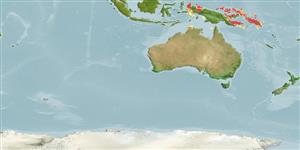>
Clupeiformes (Herrings) >
Spratelloididae (Small round herrings)
Etymology: Spratelloides: Old German, sprotte (1611) = a small fish, Clupea sp. + Greek, suffix, oides = similar to (Ref. 45335).
Eponymy: Dr Anthony David Lewis (d: 1948) is an Australian fisheries biologist and independent fisheries adviser who has joined the International Pole & Line Federation as a trustee (2014). [...] (Ref. 128868), visit book page.
Issue
The species in the genera Spratelloides Bleeker, 1851 and Jenkinsia Jordan & Evermann, 1896 should most probably be assigned to a separated family from Clupeidae and Dussumieriidae (Lavoué, pers. comm., July 2013). See a preliminary analysis in Lavoué et al. (2013: Ref. 93878).
Environment: milieu / climate zone / depth range / distribution range
экология
морской; пределы глубины 0 - 50 m (Ref. 188). Tropical; 2°N - 12°S, 130°E - 164°E (Ref. 188)
Western Central Pacific: Solomon Islands, Papua New Guinea, and off Irian Jaya.
Size / Вес / Возраст
Maturity: Lm ? range ? - ? cm
Max length : 6.0 cm SL самец/пол неопределен; (Ref. 188)
колючие лучи спинного плавника (общее число) : 0; членистые (мягкие) лучи спинного плавника (общее число) : 12 - 13; колючие лучи анального плавника: 0; членистые (мягкие) лучи анального плавника: 11 - 12. Distinguished from other species mainly by the silver band on the flanks which fades anteriorly (at about tips of pectoral fins). Maxilla toothed, triangular pre-maxillae, 2 supra-maxillae, second supra-maxilla asymmetrical (lower part larger than upper); vertical striae on scales not meeting at center; W-shaped pelvic scute.
Usually an inshore schooling species. More data needed. Used as bait in the tuna fishery. Found in coastal waters, sometimes forming large active schools at surface near reefs (Ref 90102).
Life cycle and mating behavior
половая зрелость | размножение | нерест | икра | Fecundity | личинки
Whitehead, P.J.P., 1985. FAO Species Catalogue. Vol. 7. Clupeoid fishes of the world (suborder Clupeoidei). An annotated and illustrated catalogue of the herrings, sardines, pilchards, sprats, shads, anchovies and wolf-herrings. FAO Fish. Synop. 125(7/1):1-303. Rome: FAO. (Ref. 188)
Статус Красного Списка МСОП (Ref. 130435: Version 2024-2)
Угроза для людей
Harmless
Использование человеком
рыболовство: рыболовство как средство для существования; наживка: usually
дополнительная информация
инструменты
Специальные отчеты
Скачать в формате XML
ресурсы в Интернет
Estimates based on models
Preferred temperature (Ref.
123201): 28.2 - 29.1, mean 28.8 °C (based on 16 cells).
Phylogenetic diversity index (Ref.
82804): PD
50 = 0.5625 [Uniqueness, from 0.5 = low to 2.0 = high].
Bayesian length-weight: a=0.00525 (0.00301 - 0.00914), b=3.14 (2.99 - 3.29), in cm total length, based on LWR estimates for this species & (Sub)family-body (Ref.
93245).
Trophic level (Ref.
69278): 3.0 ±0.0 se; based on diet studies.
устойчивость к внешним воздействиям (Ref.
120179): высокий, минимальное время удвоения популяции до 15 месяцев (K=4.30-8.90; tm=0.3; Fec=887).
Fishing Vulnerability (Ref.
59153): Low vulnerability (10 of 100).
Nutrients (Ref.
124155): Calcium = 2530 [213, 133,283] mg/100g; Iron = 41.7 [3.8, 409.3] mg/100g; Protein = 18.8 [14.4, 23.1] %; Omega3 = 0.227 [0.004, 13.207] g/100g; Selenium = 1810 [23, 107,595] μg/100g; VitaminA = 0.46 [0.00, 53.86] μg/100g; Zinc = 33.4 [4.1, 187.8] mg/100g (wet weight);
